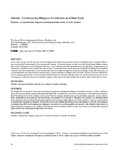Vietnam. Contemporary Religious Architecture as a Rare Good

Ver/
Use este enlace para citar
http://hdl.handle.net/2183/30288
A non ser que se indique outra cousa, a licenza do ítem descríbese como Atribución-NoComercial-CompartirIgual 4.0 Internacional (CC BY-NC-SA 4.0)
Coleccións
Metadatos
Mostrar o rexistro completo do ítemTítulo
Vietnam. Contemporary Religious Architecture as a Rare GoodTítulo(s) alternativo(s)
Vietnam. La arquitectura religiosa contemporánea como un bien escasoData
2021-12-21Cita bibliográfica
Thi Vu , T. H., & Nguyen , T. D. (2021). Vietnam: Contemporary Religious Architecture as a Rare Good. Actas de Arquitectura Religiosa Contemporánea, 8, 28-47. https://doi.org/10.17979/aarc.2021.8.0.8850
Resumo
[Abstract] In the 16th century, the first Spanish and Portuguese Dominican missionaries arrived in Southeast Asia, included Vietnam, but only after the first decades of the seventeenth century, Christianity began to take hold and lived through different episodes of the Proclamation of the Christian faith: first it was tolerated and then abandoned by the dynasties, supported by the colonialists, declined in the north by the communists, it expanded in the south under the Republic of Vietnam and stabilized until now after the reunification of the country followed by a long breakage due to political change. Along with this story, sacred architecture was interpreted in various ways to define identities in religious life and faith. However, the most difficult period of religious architecture is not only in the political conflict of the past, but also until now, the time of the economic boom. The change of values as well as the aesthetic system make sacred art and architecture remain a giant wheel stuck in mud. [Resumen] En el siglo XVI, los primeros misioneros dominicos españoles y portugueses llegaron al sudeste asiático, incluso a Vietnam, pero solo después de las primeras décadas del siglo XVII, el cristianismo comenzó a afianzarse y vivió diferentes episodios de la Proclamación de la fe cristiana: primero fue tolerado y luego abandonado por las dinastías, apoyado por los colonialistas, declinado en el al norte por los comunistas, se expandió en el sur bajo la República de Vietnam y se estabilizó hasta ahora después de la reunificación del país seguida de una larga ruptura debido al cambio político. Junto con esta historia, la arquitectura sagrada se interpretó de diversas formas para definir identidades en la vida religiosa y en la fe. Sin embargo, el período más difícil de la arquitectura religiosa no es solo en el conflicto político del pasado, sino también hasta ahora, la época del boom económico. El cambio de valores así como el sistema estético hacen que el arte y la arquitectura sagrados sigan siendo una rueda gigante atascada en el barro.
Palabras chave
Vietnam
Sacred Architecture
Genius Loci
Vatican II
System of values
Arquitectura religiosa
Concilio Vaticano II
Sistema de valores
Sacred Architecture
Genius Loci
Vatican II
System of values
Arquitectura religiosa
Concilio Vaticano II
Sistema de valores
Versión do editor
Dereitos
Atribución-NoComercial-CompartirIgual 4.0 Internacional (CC BY-NC-SA 4.0)
ISSN
2659-8671






